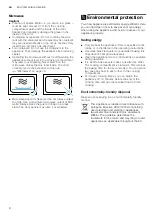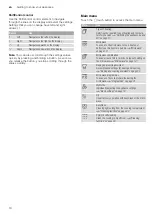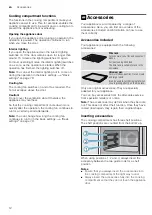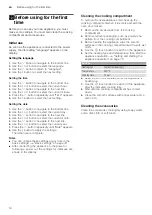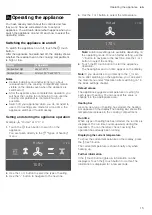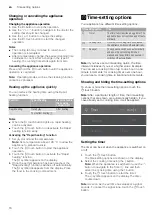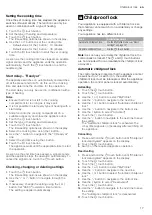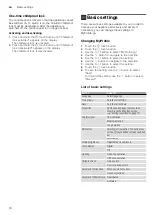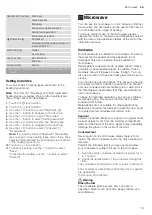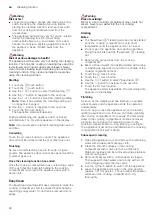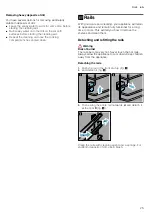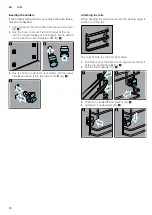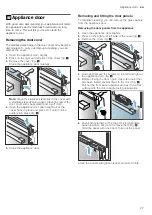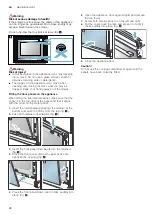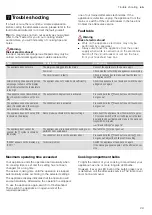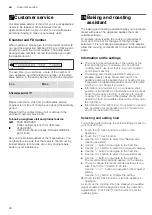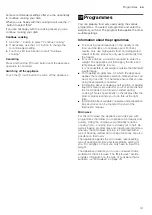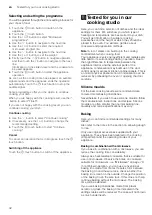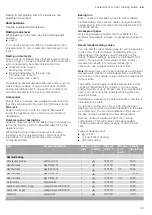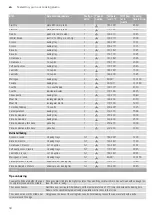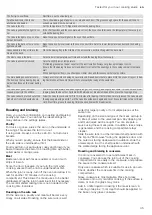
en
Cleaning agent
22
D
Cleaning agent
Cleaning
agent
With good care and cleaning, your appliance will retain
its appearance and remain fully functioning for a long
time to come. We will explain here how you should
correctly care for and clean your appliance.
Suitable cleaning agents
To ensure that the different surfaces are not damaged
by using the wrong cleaning agent, observe the
information in the table. Depending on the appliance
model, not all of the areas listed may be on/in your
appliance.
Caution!
Risk of surface damage
Do not use:
■
Harsh or abrasive cleaning agents,
■
Cleaning agents with a high alcohol content,
■
Hard scouring pads or cleaning sponges,
■
High-pressure cleaners or steam cleaners,
■
Special cleaners for cleaning the appliance while it is
hot.
Wash new sponge cloths thoroughly before use.
Tip:
Highly recommended cleaning and care products
can be purchased through the after-sales service.
Observe the respective manufacturer's instructions.
:
Warning
Risk of burns!
The appliance becomes very hot. Never touch the
interior surfaces of the cooking compartment or the
heating elements. Always allow the appliance to cool
down. Keep children at a safe distance.
--------
Notes
■
Slight differences in colour on the front of the
appliance are caused by the use of different
materials, such as glass, plastic and metal.
■
Shadows on the door panels, which look like
streaks, are caused by reflections made by the
interior lighting.
Area
Cleaning
Appliance exterior
Stainless steel
front
Hot soapy water:
Clean with a dish cloth and then dry with a soft
cloth.
Remove flecks of limescale, grease, starch and
albumin (e.g. egg white) immediately. Corrosion
can form under such flecks.
Special stainless steel cleaning products suitable
for hot surfaces are available from our after-sales
service or from specialist retailers. Apply a very
thin layer of the cleaning product with a soft cloth.
Plastic
Hot soapy water:
Clean with a dish cloth and then dry with a soft
cloth.
Do not use glass cleaner or a glass scraper.
Painted surfaces Hot soapy water:
Clean with a dish cloth and then dry with a soft
cloth.
Control panel
Hot soapy water:
Clean with a dish cloth and then dry with a soft
cloth.
Do not use glass cleaner or a glass scraper.
Door panels
Hot soapy water:
Clean with a dish cloth and then dry with a soft
cloth.
Do not use a glass scraper or a stainless steel
scouring pad.
Door handle
Hot soapy water:
Clean with a dish cloth and then dry with a soft
cloth.
If descaler comes into contact with the door han-
dle, wipe it off immediately. Otherwise, any stains
will not be able to be removed.
Appliance interior
Enamel surfaces Hot soapy water or a vinegar solution:
Clean with a dish cloth and then dry with a soft
cloth.
Soften baked-on food residues with a damp cloth
and soapy water. If there are heavy deposits of
dirt, use a stainless steel scouring pad or oven
cleaner.
Leave the cooking compartment open to dry after
cleaning.
It is best to use the cleaning function.
"Cleaning function" on page 23
Glass cover for
the interior light-
ing
Hot soapy water:
Clean with a dish cloth and then dry with a soft
cloth.
If the cooking compartment is heavily soiled, use
oven cleaner.
Stainless steel
door cover
Stainless steel cleaner:
Observe the manufacturer's instructions.
Do not use stainless steel care products.
Remove the door cover for cleaning.
Stainless steel
interior door
frame
Stainless steel cleaner:
Observe the manufacturer's instructions.
This can be used to remove discolouration.
Do not use stainless steel care products.
Rails
Hot soapy water:
Soak and clean with a dish cloth or brush.
Pull-out system
Hot soapy water:
Clean with a dish cloth or a brush.
Do not remove the lubricant while the pull-out rails
are pulled out – it is best to clean them when they
are pushed in. Do not clean in the dishwasher.
Accessories
Hot soapy water:
Soak and clean with a dish cloth or brush.
If there are heavy deposits of dirt, use a stainless
steel scouring pad.

